At a time when there is so much discussion about Rollkur, deep and low, and stretching, The Horse Magazine was privileged to see a demonstration of how-it-should-be-done by Ingrid Klimke.
Ingrid Klimke – Beautiful Basics – Dresden Man and Damon Hill at home.
Ingrid, like her late father, Dr Reiner Klimke, has the gift of being able to explain the basics simply, and then even more importantly demonstrate those qualities with her relaxed well trained horses. Here Ingrid is watching her Bereiter warm up the five-year-old stallion, Dresden Man. He’s just out of the stable and has walked around the arena while Ingrid was riding Damon’s Divene for us.
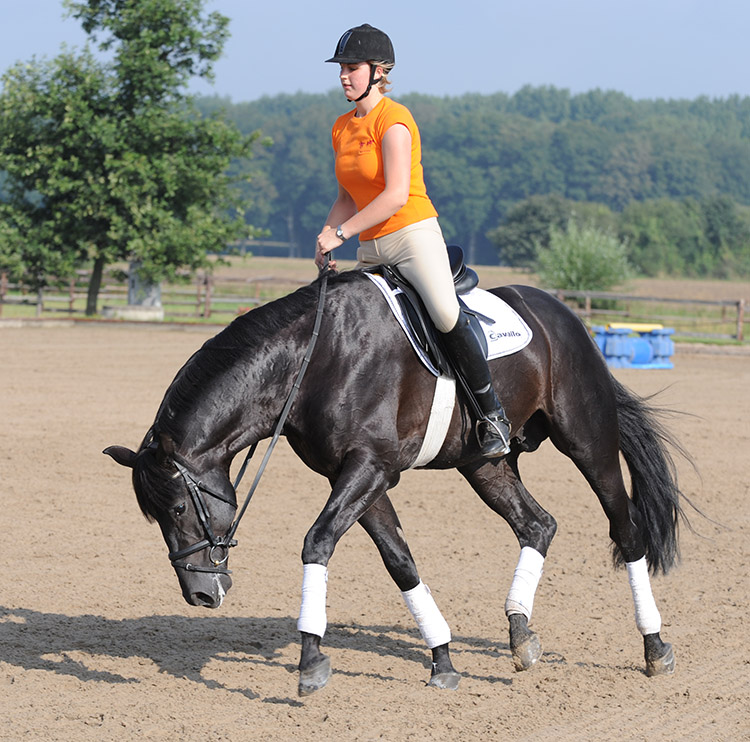
“I think it really shows he stretches from the wither, really down, and makes his neck really long, and the nose forward, that is important. Some horses crawl behind the vertical, holding their nose very tight to their chest, then you feel that the back is still tight – the stretching must be from the hindleg over a swinging loose back, and then stretch really down. You see how long his neck is and he is still saying, softy, yes, I know the way is free. My father always said, think of stretching the nose to the sand. Think that as a rider you can always give more and more, the horse will tell you how much he really needs to open up, from the tail, right through the vertebrae, through the neck, really stretched and round like a ball. If they just roll back and you have no contact, that is something I really don’t like, because they are still tight and hold their back and they seem to make their neck round, but the back is tight.”
“Here you see Dresden very nicely over the cavalletti, he is actively stepping – see his hind leg – and searching – ‘oh give me more’.”
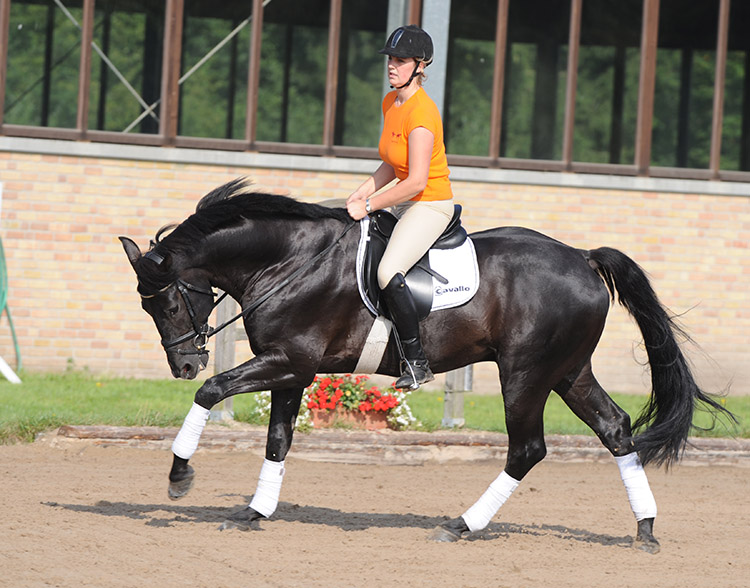
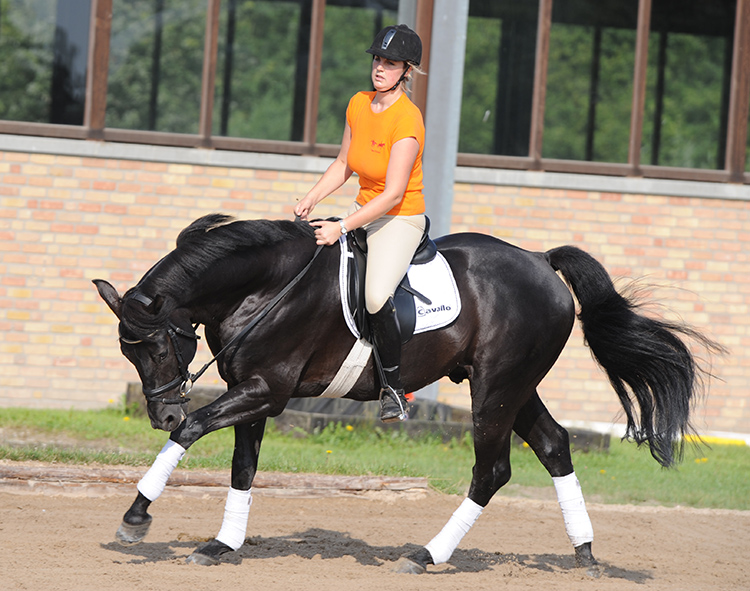
Ingrid takes over after Dresden is warmed up.
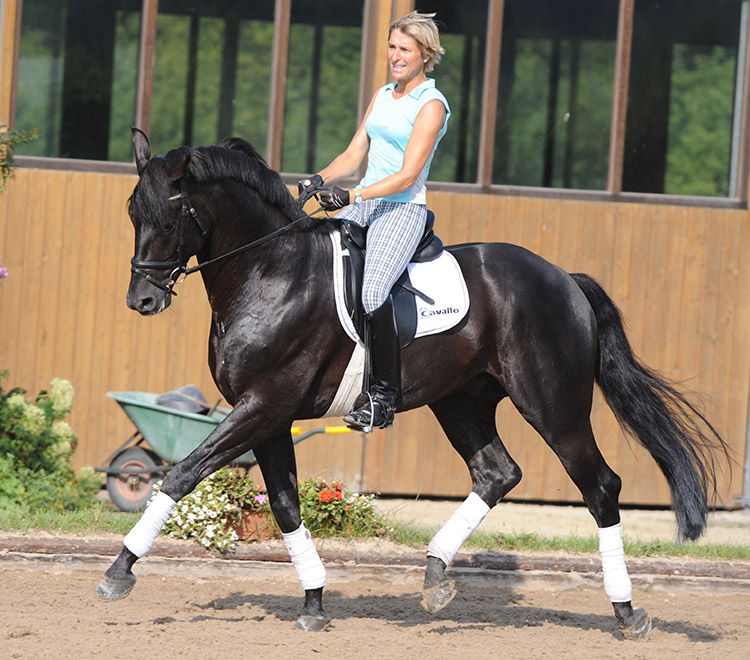
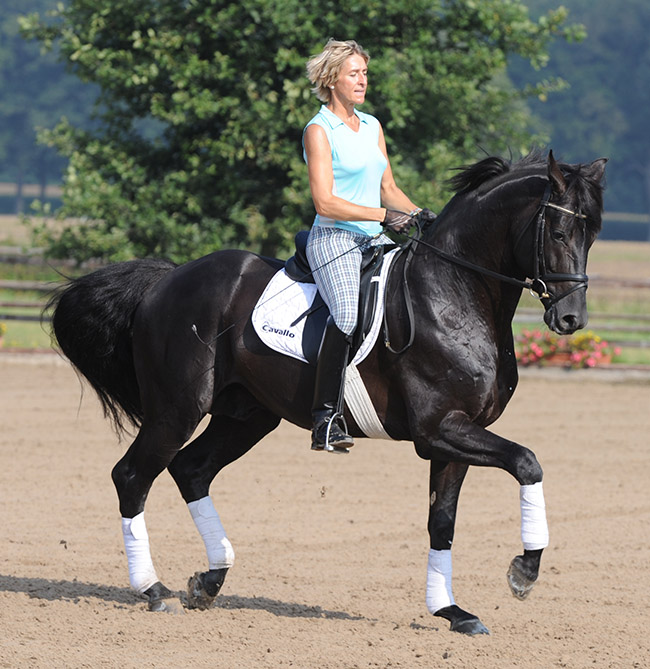
“It is so important that you do a proper warmup and make sure everything is loose and supple, then give a walk break – and then you can start sitting, and say okay, you have stretched down as far as you can and need. Then I can be very strict and say, okay the poll is the highest point, the nose must be in front of the vertical because what I want is the hind leg engaged underneath. If the horse is too far down, then where will the hind legs be? We must always think that the hindlegs are sitting, so the horse can be in balance and in its natural self-carriage – natural self-carriage means the more advanced he is, the more schooled he is, the more he can sit on his hocks, the shorter he will look. Later in the piaffe we will see him higher in the front and lower behind, but for a five-year-old, this is his natural look. He is quite short naturally, he is quite a compact horse and with him you must be sure when you sit on him, because he doesn’t have so much behind, that he has freedom in the front to present. If the front is tight, and he is short behind the saddle, then the horse would be totally tight, and the back one day would be blocked because he is holding himself hollow.
Dresden Man finished in the top six in the very strong Five-Year-Old Final at the Bundeschampionat.
The last horse we watched Ingrid work that day was Ingrid and the Grand Prix stallion, Damon Hill. This is only his first season at this level and Ingrid was working on building his strength.
“First of all I worked in canter with the cavallettis. I do this exercise on the turning line because in the pirouette, the horse has to carry his whole weight on the inside hind leg and the stronger the leg is, it means that he can really sit/turn, sit/turn. So for the left pirouette, I work on the cavalletti with a turning line to the left, then he opens up his back – that’s why I sit a little bit lighter – and the inside leg is already there under him. Try to focus on strength, make him really supple over his back and then you can collect stride by stride, making the circle smaller, keeping the flexion, keeping his inside leg active with your inside leg, then you can easily turn stride by stride in a big working canter pirouette.”
“The cavalletti helps you stay in the rhythm, because sometimes horses make one stride a little bit bigger than the other and that means loss of rhythm, it must be stride, stride, stride, all in rhythm, and not one stride small, one big. You must have the same rhythm before the pirouette, in the pirouette and out of the pirouette. If you change gear then all of a sudden the balance is gone, that’s why I think the cavalletti helps, going round, round, rhythm, rhythm. And it is the same in the pirouette.”
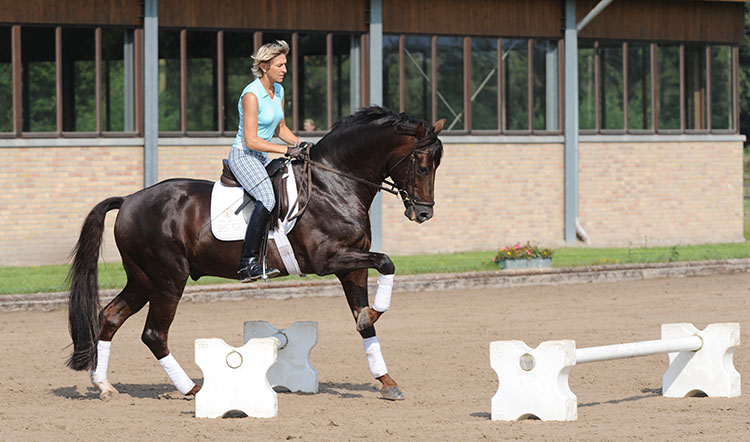
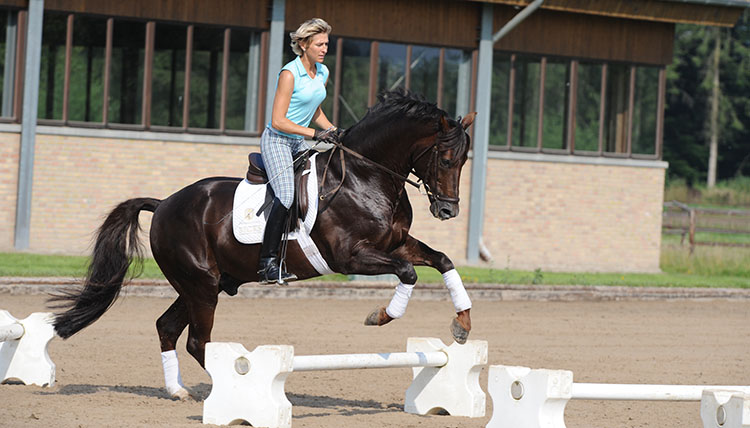
Next Ingrid went into canter with her stirrups crossed and started flying changes, we asked if this was an exercise for Ingrid, or for Damey…
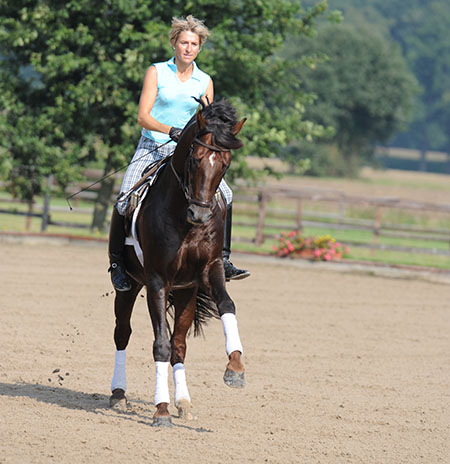
“I want to sit more, and if I have the stirrups, it’s easy that you lighten your seat using the stirrup, and then if you use the stirrups, your upper body starts to go a little bit from side to side (we’ve all seen that happen) and then also the horse will go from side to side. If you as a rider have your strength in your seat, if you really can sit totally straight and keep your butt in the saddle, so you don’t move, you sit in balance. Sit in your saddle, go with the rhythm, into your horse and you let the change strides out, out, out. If you lean forward, and lift up out of the saddle, then the hind legs are not under control and the horse can come on the forehand, his hind leg starts to come up not under, and he starts to swing. That’s why sometimes it is a good idea to put away the stirrups and say ‘oh do I really sit?’ Sit back, look to your point, keep your hands totally quiet and try to guide him.”
Many thanks once again to Ingrid for taking the time to tell and show us how it should be done.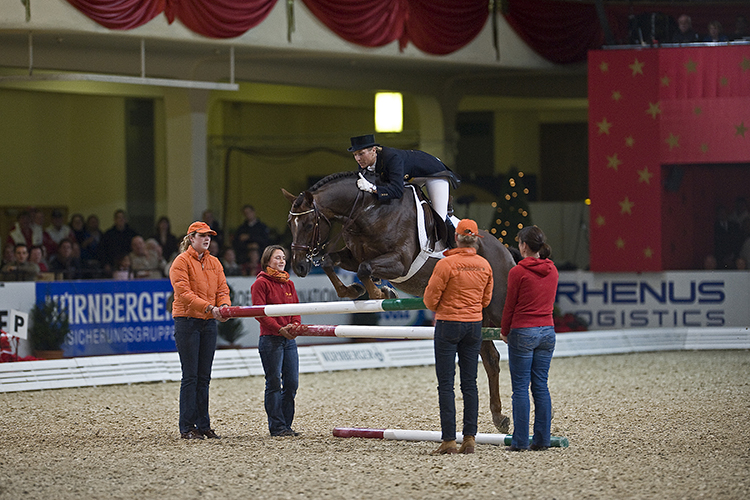
Ingrid, Damon Hill and Ingrid’s team demonstrate good training after their win in the Nürnberger Burg Pokal Final in Frankfurt, a competition which was the idea of the late Dr Klimke to help develop young Grand Prix horses. Jumping at the presentation is Ingrid’s idea, but one feels sure Dr Klimke would endorse it.
Stallions from the ‘D’ line, famous for rideability and top dressage performance, are available in Australia through International Horse Breeders, stallions like Delight, and many more. Go to www.ihb.com.au and find the right stallion for your mare.
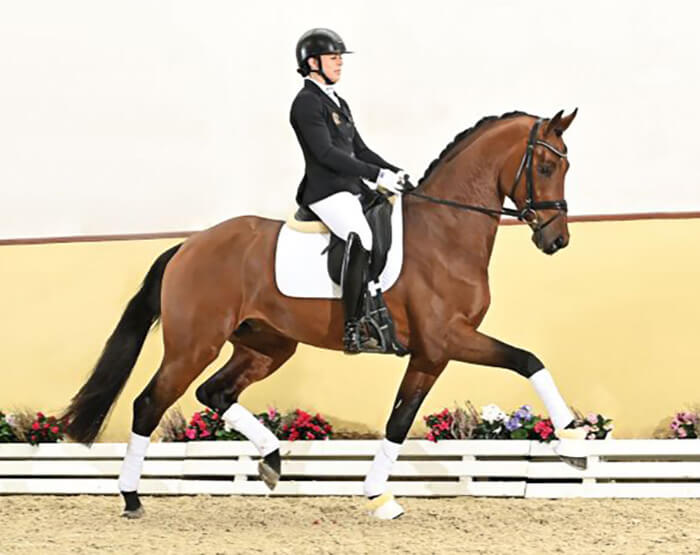



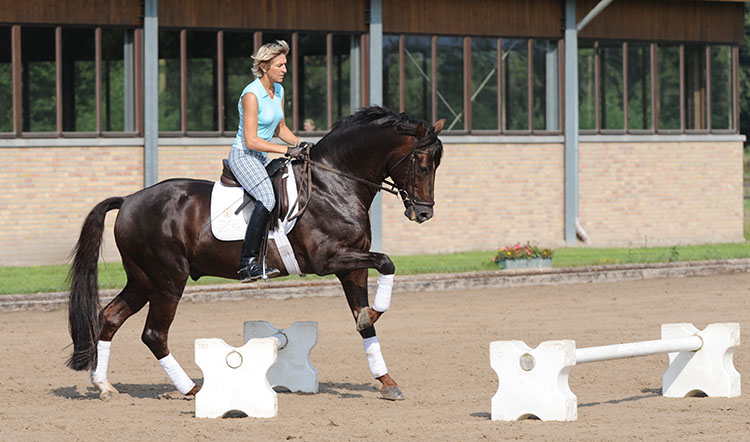
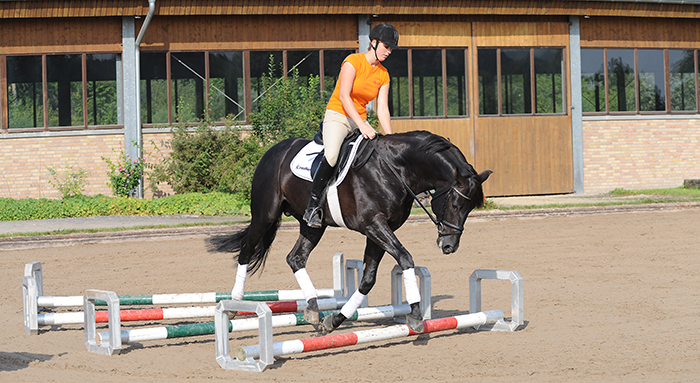
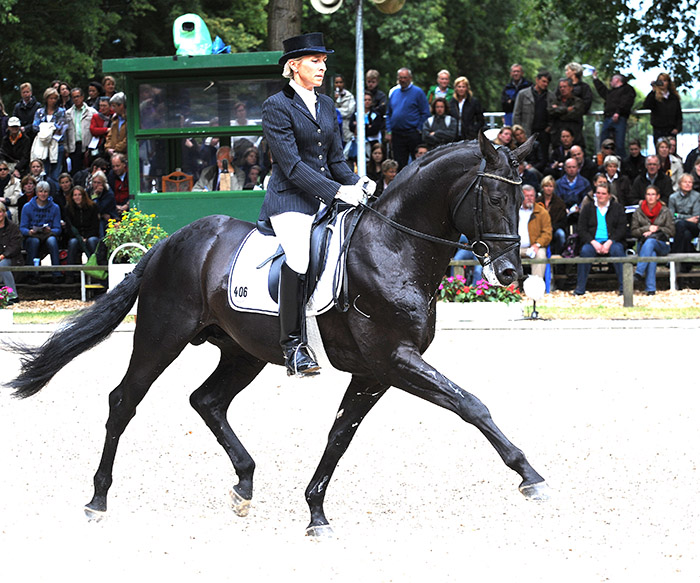
It is so nice to see “working athletes” who are supple and relaxed through the back and in front of the vertical when in their working phase of their session and long and low, stretching fully through their back when warming up or being rewarded. It is really beautiful to watch and represents trust, respect and fun on both parts of the partnership.
I very much appreciate the emphasis on the seat (and not the hands) being the centre of power for the rider.
Very informative article which is well illustrated!
Thank you soo much!
Kirstin
The same fot me!
Deal mrs. Klimpke you are my favorit rider- please dont Ride without helmet, a broken bone Can be fixed a demage head can turnyou into a whelel chair driver for ever with regards ar
Readers please note – this article was written well before helmets became compulsory for riders.